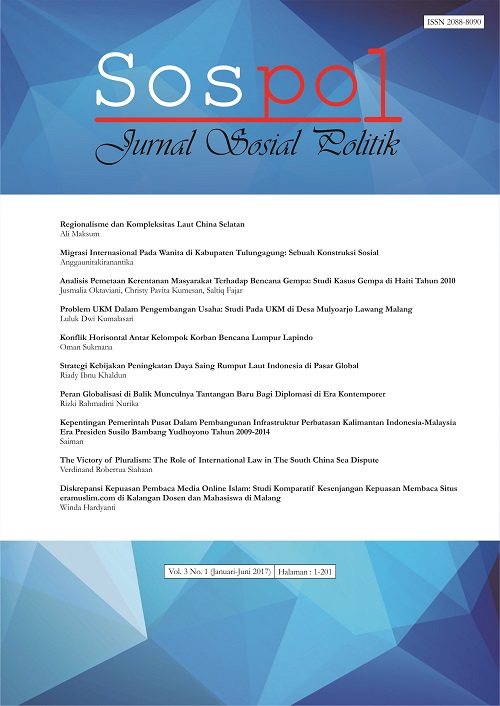Konflik Horisontal Antar Kelompok Korban Bencana Lumpur Lapindo
DOI:
https://doi.org/10.22219/sospol.v3i1.4402Abstract
Abstrak
Fenomena yang menjadi fokus perhatian dalam penelitian ini adalah fenomena konflik yang terjadi antar kelompok korban bencana Lumpur Lapindo (Lula) di Sidoarjo. Penelitian ini bertujuan untuk mengkaji tentang: (1) Bagaimana proses terbentuknya kelompok-kelompok korban bencana Lumpur Lapindo hingga terjadinya konflik antar kelompok korban bencana Lumpur Lapindo di Sidoarjo; (2) Faktor-faktor apakah yang menyebabkan terjadinya konflik horisontal antar kelompok korban bencana Lumpur Lapindo di Sidoarjo; dan (3) Bagaimana bentuk-bentuk konflik horisontal antar kelompok korban bencana Lumpur Lapindo di Sidoarjo. Penelitian ini menggunakan pendekatan kualitatif, jenis penelitian studi kasus, teknik analisa data deskriptif-kualitatif, dan teknik pengumpulan data meliputi indeepth interview, Focus Group Discussion, observation, dan documentation. Hasil penelitian menunjukkan bahwa korban bencana Lumpur Lapindo membentuk kelompok sebagai wadah dalam memperjuangkan hak-hak mereka. Terdapat dua kelompok utama korban bencana Lumpur Lapindo, yakni kelompok GKLL dan kelompok Pagarekorlap, namun kelompok ini mengalami friksi dan perpecahan dalam tiga hal yakni perubahan nama kelompok, bentuk tuntutan proses pembayaran ganti rugi, dan strategi aksi, sehingga menimbulkan konflik horisontal antara kelompok korban bencana Lumpur Lapindo dalam bentuk: konflik kepentingan, konflik strategi aksi, dan konflik mekanisme tuntutan ganti rugi.
Kata kunci: Bencana, Konflik, Kelompok.
Abstract
A phenomenon that became the focus of attention in this study is the phenomenon of conflict between groups of Lapindo mudflow disaster victims (Lula) in Sidoarjo. This study aims to assess: (1) How is the process of formation of the groups and conflict between groups Lapindo mudflow disaster victims in Sidoarjo?; (2) What factors are causing horizontal conflicts between groups Lapindo mudflow disaster victims in Sidoarjo?; and (3) How the forms of horizontal conflicts between groups Lapindo mudflow disaster victims in Sidoarjo?. This study used a qualitative approach, case study research, data analysis techniques descriptive qualitative, and data collection techniques include indeepth interviews, focus group discussions, observation, and documentation. The results showed that Lapindo mudflow disaster victims formed the group as a forum in Struggle their rights. There are two main groups of Lapindo mudflow disaster victims,namely GKLL groups and groups Pagarekorlap, however this group experienced friction and split in three ways ie change the group name, the form of demands compensation payment process, and action strategies, causing horizontal conflicts among groups Lapindo mudflow disaster victims in the form of: a conflict of interest, conflict action strategy, and conflict redress mechanism.
Keywords: Conflicts, Disasters, Group.
Downloads
Downloads
Published
How to Cite
Issue
Section
License
Authors who publish with this journal agree to the following terms:
- Authors retain copyright and grant the journal right of first publication with the work simultaneously licensed under a Creative Commons Attribution-ShareAlike 4.0 International License that allows others to share the work with an acknowledgement of the work's authorship and initial publication in this journal.
- Authors are able to enter into separate, additional contractual arrangements for the non-exclusive distribution of the journal's published version of the work (e.g., post it to an institutional repository or publish it in a book), with an acknowledgement of its initial publication in this journal.
- Authors are permitted and encouraged to post their work online (e.g., in institutional repositories or on their website) prior to and during the submission process, as it can lead to productive exchanges, as well as earlier and greater citation of published work (See The Effect of Open Access).

This work is licensed under a Creative Commons Attribution-ShareAlike 4.0 International License.



















